ASUS UL80Vt and G51J: Going for the Gold
by Jarred Walton on December 15, 2009 1:30 AM EST- Posted in
- Laptops
ASUS UL80Vt Application Performance
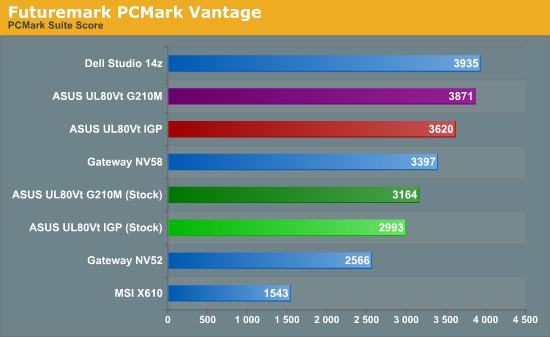
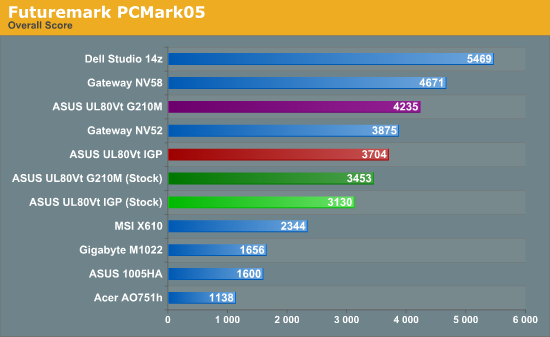
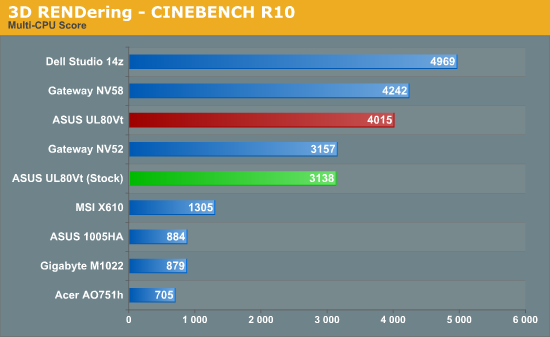
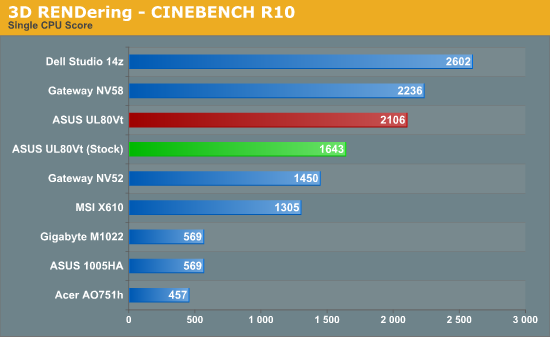

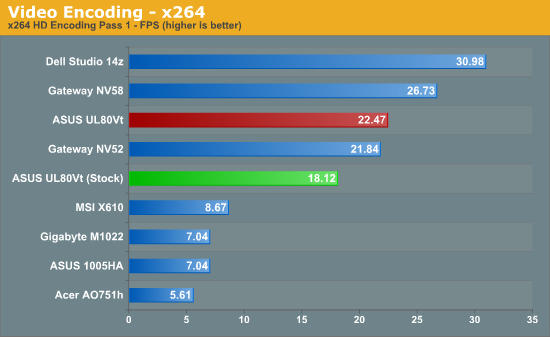
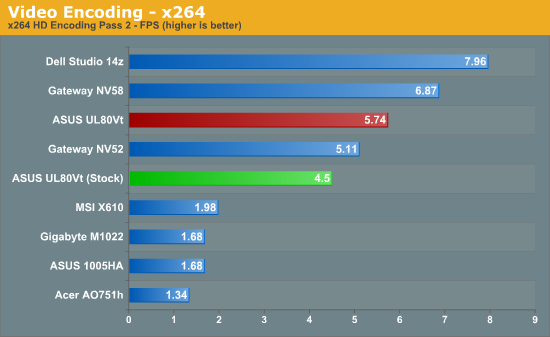
With Turbo33 and the G210M enabled, the UL80Vt is neck-and-neck with the Dell Studio 14z in PCMark Vantage, the most comprehensive picture of general application performance. PCMark05 places more of an emphasis on CPU clocks, so the 14z with P8600 ends up around 30% faster. That ~30% advantage holds when we move to CPU intensive applications like video encoding and 3D rendering where the 14z is 38% and 23% faster, respectively.
If you prefer battery life and want to disable the G210M and run the CPU at stock speed, the gap between the UL80Vt and the 14z grows substantially. PCMark Vantage shows a 31% advantage, PCMark05 75%, CINEBENCH 58%, and video encoding around 75% - not that you're likely to try doing video encoding or 3D rendering while unplugged on this sort of laptop.
If you want a different comparison that shows exactly why we're so keen on CULV laptops, take a look at the stock IGP configuration of the UL80Vt and compare that with any of the netbooks. In that case, the UL80Vt is over twice as fast in PCMark05 and 2.5 to 3.5 times faster in CPU intensive tasks like video encoding and 3D rendering. Sure, the UL80Vt costs over twice as much as a typical Atom-based netbook, but there are plenty of other CULV laptops with prices starting at $400 for the Acer 1410. The PCMark figures are a good indication of our experience: dual-core CULV is dramatically faster than Atom, to the point where if price is similar we wouldn't even consider Atom.










66 Comments
View All Comments
JarredWalton - Tuesday, December 15, 2009 - link
I'm curious to see how it works as well. I'm thinking CULV + 9400M would have accomplished much the same thing, but perhaps not. Stay tuned....yacoub - Tuesday, December 15, 2009 - link
Here's hoping it comes with a quality display! ;)JarredWalton - Wednesday, December 16, 2009 - link
One word: NOPE!Okay, more than one word: When you boot up a laptop for the first time and the black background of the Windows loading screen looks more like dark gray, you know the contrast ratio is crap. Bleh.
Ditiris - Tuesday, December 15, 2009 - link
I finally switched my HTPC over to Windows 7 and noticed that it had a mind of its own with regard to power settings.power settings, change plan settings, change advanced power settings, expand Sleep and Allow wake timers, Disable any that are there
That fixed all my issues, even though I didn't have any sleep/wake timers, but disabling the ability seems to be important.
I haven't had any issues with my Vista machines (FWIW I'm using High Performance and I specifically went into the Advanced screen and disabled all sleep options).
JarredWalton - Tuesday, December 15, 2009 - link
The wake events are already disabled, unfortunately. Some laptops exhibit the problem less than others (driver related perhaps), but my best guess is that somewhere there's a rogue line of code that gets invoked on occasion. I've actually fooled around hacking the registry on my personal laptop in order to keep the problem from reoccurring, but that was neither fun nor recommended for the faint of heart!mczak - Tuesday, December 15, 2009 - link
Again I have to wonder what the point of the OC CULV chip is. There's a ~10W difference (at full cpu load) between OC and non-OC, which means it is almost certainly also overvolted, but more importantly, that difference is larger than the TDP difference between CULV parts and (slightly faster) LV parts.Looks to me like using a LV part instead of OC CULV would be both a bit faster plus actually offer slightly more battery life (unless, of course, you use stock setting of the CULV).
JarredWalton - Tuesday, December 15, 2009 - link
It's pretty much giving users the ability to run with long battery life and when desired get better performance. If it were an on-the-fly setting, it would be a lot better. Anyway, even overclocked the SU7300 in the UL80Vt idles at what appears to be 2W, where something like the P8600 appears to idle at close to twice that (4-5W). It would be interesting to see some of the LV CPUs in a similar system, certainly... SL9600 anyone? Or maybe ASUS should grab an SL9380 and enable the same Turbo33 functionality. 1.8GHz stock and 2.4GHz overclocked. That would be the equivalent of P8600 (with 6MB cache) but hopefully allow lower power at idle.kagey - Tuesday, December 15, 2009 - link
BTW - Nice reviews!I may have missed this so slap me if I did but It would be helpful including some sort of standard about these two in the evaluation of a laptop. I feel these two points are just as important as performance and battery life.
Both are subjective but should be able to be measured while web surfing, gaming, and full load.
Noise factor of the fans. I hate it when you start doing something on the laptop and all of sudden the fans kick in and sound like a jet taking off. It would be nice if you could come up with some standards in the way of noise.
Heat - the palm rest when typing, touchpad / mouse area, underneath i.e. (keeping your legs nice and warm - yeah I know not the most optimal position for a laptop), and exhaust areas.
Thanks for listening.
JarredWalton - Tuesday, December 15, 2009 - link
I didn't mention either, but I did think about them during the review process. For the record, the UL80Vt is very quiet and cool running. When the fans kick up to higher speeds, it still remains a lot quieter than most laptops... maybe around 37-40 dB max, and it doesn't happen unless you put a heavy load (100% CPU or running games) on the system.The G51J gets louder, but it's not as bad as the W870CU. For most tasks it will stay under ~35dB, but gaming will bump it up to around 39-41dB. Heat was not an issue on the G51J in my experience; the palm rest gets warm, perhaps up to 90F, and the bottom is the same except for the top-right corner (directly under the CPU/GPU "circle") which gets over 100F for sure.
Wesleyrpg - Tuesday, December 15, 2009 - link
hey guys, love the asus g51j, had one for a few days myself!only problem is the mic on my one makes me sound like im in a subway (tried all the settings i could think of!).....have you guys had a chance to test your mic on livemessenger/ventrilo???